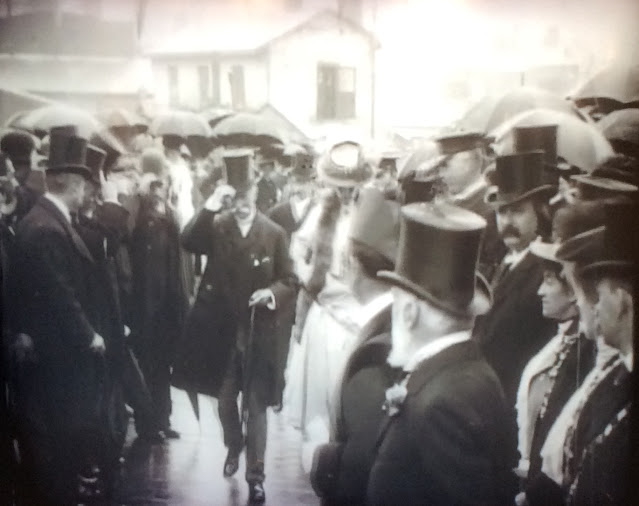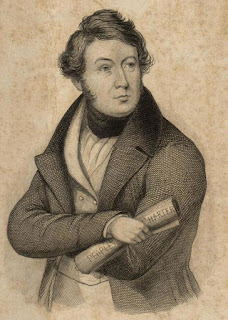NEWPORT TRANSPORTER BRIDGE IN FILM by Richard Frame
Newport Transporter Bridge in film
There is currently an exhibition of the construction of the Transporter Bridge as seen via the photos and artefacts in the Museum. Here is an article by Richard Frame of the Transporter Bridge in Film.
1906 The Earliest Film
The earliest film of the Transporter Bridge relates to its opening in 1906 but the film was not discovered until 1987. The newly formed Newport Maritime Trust had been in touch with film historian John Huntley regarding a chance discovery of some film featuring the Transporter Bridge. Huntley had spent many years working for the British Film Institute but in 1974 retired and set up Huntley Film Archives. A favourite pastime of Huntley’s was rummaging through the bric a brac barrows of the east end of London. He had amassed a collection of old film this way, but one film he bought for five shillings had him stumped. It wasn’t until he took a train journey to Cardiff and was crossing the River Usk at Newport that he spied the unmistakable shape of the Transporter Bridge. As part of a fundraising project for Newport Maritime Trust, Huntley brought the film together with a selection of railway films to the Newport Centre on March 31st 1987. This remarkable film was made at the opening of the bridge on 12th September 1906 by an anonymous camera man who clearly had been given official approval as the positioning of his camera on the gondola proved.
 |
| Lord Tredegar arrives to officially open the Transporter Bridge |
The weather was dreadful as it was misty and raining with many of the onlookers on the river banks holding umbrellas. However, the dignitaries stepping aboard the gondola were led by on officer in a tricorn hat and clutching a mace and left themselves exposed to the miserable weather. Mayor Liscombe and his wife led the party with Viscount Tredegar arriving shortly afterwards and after a couple of introductions the gondola gently moved off to the opposite bank. Through the murk on its return a small gang of children are spotted running along the muddy river bank just below the embarkation spot. The crowd was held well back on the doorstep of the West of England pub, but a large boat, the Elswick Park is tied up alongside with crowds of onlookers pressed against the stern railings. A copy of this important documentary film now resides in the collection of Newport Museum and Art gallery.
1959 Tiger Bay
In March 1959 the film ‘Tiger Bay’ featuring the young Hayley Mills and her father John was released. The story revolved around the docklands of Cardiff in which John Mills, a Police Superintendent investigates a murder which the young Hayley has witnessed.
The transporter bridge features twice in the film, once during the opening scene when merchant seaman Bronislav Korchinsky, (Horst Buchholz) arrives in Cardiff following a voyage at sea, and secondly when Gillie Evans (Hayley Mills) crosses it at night with Korchinsky to evade capture from the Police.
The South Wales Argus had a carried a story announcing that shooting was about to take place and scores of people had gathered around Watch House Parade. Many Newport people have memories of those few exciting days. One family had taken their border collie down with them and having noticed him Hayley Mills would now and again pop over and stroke him. Others remember flood lights being erected on the roof of the West of England pub and some recall the Waterloo public bar being taken over and used as a set but sadly, if this was the case, it was never used in the film. Twelve year old Hayley Mills in her first professional acting role recalled in 2006, “I spent a thrilling and very chilly night on this lady, shooting my first movie hanging over the inky blackness of the river Usk”.
Hayley’s performance did not go unnoticed and in 1959 she won the ‘Special prize’ at the 9th Berlin International Film Festival and in 1960 won a BAFTA for most promising newcomer to film. But despite her success and the film doing well at the British box offices no offers were forthcoming for work in the UK. It was Walt Disney who spotted her talent and they offered her the lead in “Pollyanna” which launched her career as a movie star. Around the time of the 100th anniversary of the opening of the bridge Hayley Mills became the Honary Life Vice President for the Friends of Newport Transporter Bridge and in 2019 she returned to the bridge writing in the visitors book “the last time I was here was in 1958 and it’s wonderful to see this grand old lady in great shape”.
“Tiger Bay” was one of the first of the British New Wave films to emerge, deliberately shot to create a spontaneous pseudo-documentary appearance. Filmed in black and white and using real people in real locations it added to this new art form of social realism. So perhaps it was no coincidence that just seven years later one of the first film schools opened in Newport.
The foundation of Newport film school in 1966
In the early 70’s Newport Art College was on four sites, fine art and graphics at Clarence Place, sculpture department in Bolt Street, fashion school in Charles Street and the Foundation department and film school in Fairoak Road. John Wright the principal had recognised that adding a film school to the college’s portfolio would attract more students and enhance the colleges growing reputation.
John Grierson, who has been described as the father of British documentary films, was in Cardiff in 1965 helping to organise the Commonwealth Film Festival. Grierson had recently poached a young up and coming BBC editor Harley Jones to help him with this work. Wright who knew Grierson persuaded him to help produce a report outlining the viability of opening a film school in Newport. Wright was supported by the local education department and in 1966 Harley Jones was appointed to run the new department. Jones was to run the school successfully until he moved to the newly created S4C in 1982 as a producer. The film school continued for 50 years until finally being subsumed by the University of Wales and moving to Cardiff. A number of short films about the transporter bridge were made by students but none have survived.
‘Softly Softly’ The Detective Series 1966
On the 16th March 1966, during the first series of new Police drama , ‘Softly Softly’, the transporter bridge appeared on the BBC. Although the first three series of this new drama, set around Bristol in the fictional region of Wyvern went out live, this particular shot was recorded on location on the 1st March.
1974, I take part in a film
In 1974 two ex-Newport art students Steve Stevenson and Maggie Brooks returned to Newport to complete their first years project as students in the recently created National Film School in Beaconsfield. They had pooled their funding to make the appropriately named film ‘Newport’. It told the story of an unhappy young couple, Phil a depressed and unpleasant man who was trying to get his foot in the fashion industry and his unappreciated girlfriend Sue who worked as a seamstress in a local factory. The film opened with Phil begrudgingly walking Sue to work in the early hours of the morning. They cross on the transporter bridge with Sue arriving late as usual. I had been asked to play the part of Phil, whilst ex-student Cathy Cooper had taken the role of Sue.
 |
| Cathey and Richard in the Transporter Bridge |
 |
| Richard and Cathy on the Dockside |
I had arrived in Newport in 1971 to study fine art I’d find myself crossing the town bridge almost daily. I could see the transporter bridge in the distance but never took much of an interest in it and never ventured down to see it. It was very early on a bitterly cold Sunday morning around Easter when I eventually found myself standing on the west bank of the Usk watching as the gondola slowly creaked its way across the brown river. The local authority had generously loaned Steve the bridge for the day together with the driver and its conductor, whose job it was to open and close the gates as well as taking the fares. Even the Police had loaned an officer to make sure no one attempted to get on the bridge during the day’s filming. The first take meant climbing to the top, where camera man Ben Bolt filmed the gondola moving off from the west bank whilst the sound man, appropriately name Dave Bridges, recorded the rattling and creaking of the wheels, the squeaking of the cables and the hoot hoot of the boats manoeuvring on the river below. Back down on the gondola the shooting continued with the depressed couple discussing whether they would be going to a local dance that evening. A peck on the lips and they part, Sue heading off to the factory. A total of 1.86 minutes screen time.
On the top of the bridge. The camera man Ben Bolt is a famous director now. His father was Robert Bolt.
Flight to Freedom 1989
In 1989 another movie “Flight to Freedom” was partly filmed on the east banks of the river. It's difficult to be sure what this film was about. It has been suggested it was a musical and was based on the escape of Austrian singer and film star Richard Tauber from Nazi Germany to Austria prior to the outbreak of World War Two. The film which was never completed seems to have been the brain child of a London businessman Terry Pope who stumbled across Newport singer John Cortez (nee Tommy Evans) down on his luck in a London tube station. Not only did Pope assist Cortez in making a record album he financed the movie “Flight to Freedom”. Cortez was even given the starring role of Tauber and the scene shot at the bridge in 1989 seems quite bizarre. The photographs taken on the day of filming show an old horse drawn red London bus, with what appears be a Bavarian brass band with Cortez conducting them on the top deck. The bus sits at the foot of the engine room, which has been decked out in Nazi flags, and surrounding the bus are rifle wielding soldiers with their weapons raised and pointing at Cortez dressed as the band leader. It was a great pity that the film was never completed so that the mystery could have been revealed as to what the Rogerstone Brass Band and Newport singer John Cortez were up to. It appears, to have been a completely fictional event in the colourful life of Richard Tauber.
Richard Frame




Comments
Post a Comment